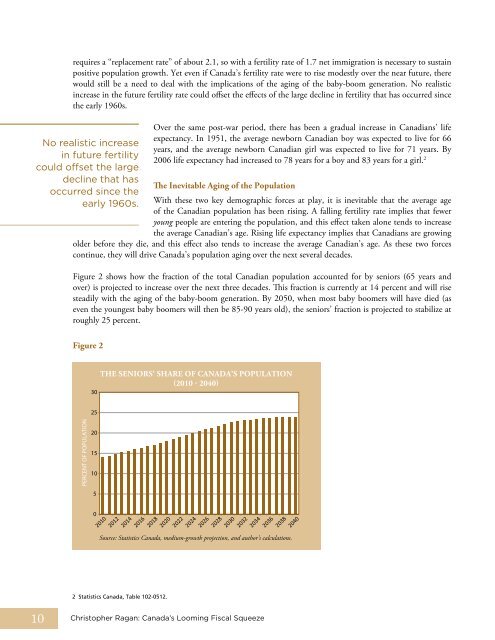Christopher Ragan, "Canada's Looming Fiscal Squeeze," November
Christopher Ragan, "Canada's Looming Fiscal Squeeze," November
Christopher Ragan, "Canada's Looming Fiscal Squeeze," November
Create successful ePaper yourself
Turn your PDF publications into a flip-book with our unique Google optimized e-Paper software.
10<br />
requires a “replacement rate” of about 2.1, so with a fertility rate of 1.7 net immigration is necessary to sustain<br />
positive population growth. Yet even if Canada’s fertility rate were to rise modestly over the near future, there<br />
would still be a need to deal with the implications of the aging of the baby-boom generation. No realistic<br />
increase in the future fertility rate could offset the effects of the large decline in fertility that has occurred since<br />
the early 1960s.<br />
No realistic increase<br />
in future fertility<br />
could offset the large<br />
decline that has<br />
occurred since the<br />
early 1960s.<br />
over the same post-war period, there has been a gradual increase in Canadians’ life<br />
expectancy. In 1951, the average newborn Canadian boy was expected to live for 66<br />
years, and the average newborn Canadian girl was expected to live for 71 years. by<br />
2006 life expectancy had increased to 78 years for a boy and 83 years for a girl. 2<br />
The Inevitable Aging of the Population<br />
With these two key demographic forces at play, it is inevitable that the average age<br />
of the Canadian population has been rising. A falling fertility rate implies that fewer<br />
young people are entering the population, and this effect taken alone tends to increase<br />
the average Canadian’s age. rising life expectancy implies that Canadians are growing<br />
older before they die, and this effect also tends to increase the average Canadian’s age. As these two forces<br />
continue, they will drive Canada’s population aging over the next several decades.<br />
Figure 2 shows how the fraction of the total Canadian population accounted for by seniors (65 years and<br />
over) is projected to increase over the next three decades. This fraction is currently at 14 percent and will rise<br />
steadily with the aging of the baby-boom generation. by 2050, when most baby boomers will have died (as<br />
even the youngest baby boomers will then be 85-90 years old), the seniors’ fraction is projected to stabilize at<br />
roughly 25 percent.<br />
Figure 2<br />
PERCENT OF POPULATION<br />
30<br />
25<br />
20<br />
15<br />
10<br />
5<br />
0<br />
THE SENIoRS’ SHARE oF CANADA’S PoPuLATIoN<br />
(2010 - 2040)<br />
2010<br />
2012<br />
2014<br />
2016<br />
2018<br />
2020<br />
2022<br />
2024<br />
2026<br />
2028<br />
2030<br />
2032<br />
2034<br />
2036<br />
2038<br />
2040<br />
Source: Statistics Canada, medium-growth projection, and author’s calculations.<br />
2 Statistics Canada, Table 102-0512.<br />
<strong>Christopher</strong> <strong>Ragan</strong>: Canada’s <strong>Looming</strong> <strong>Fiscal</strong> <strong>Squeeze</strong>





